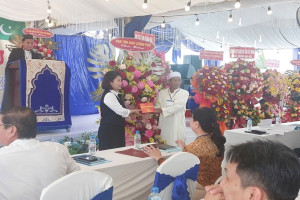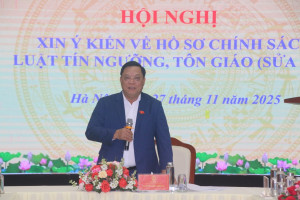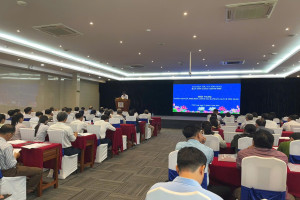
(after reading the "The reciprocal influence between Catholicism and Vietnamese culture" written by Dr. Pham Huy Thong)
Catholicism is not a new topic in Vietnam. Many researchers have dealt with it from different angles. But I have new impressions about religions after reading book "The reciprocal influence between Catholicism and Vietnamese culture" (reciprocal influence, for short) written by TS. Pham Huy Thong. It has published by Religious Publishing in November, 2012
First of all, this book is treatise. It reflects some philosophical problems. Although the writer does not use the concept of philosophical dialectics, dialectical method is manifested in each page of this book. The title of the book shows that writer wants to analyze dialectical interaction between two subjects: Catholicism and Vietnamese culture. When dealing with this problem some writers only state positive or negative aspects of Catholicism. The writer of book "reciprocal influence" has an objective outlook when he remarks that: "Obviously, when Catholicism puts his seals on Vietnamese culture, Vietnamese culture put traditional dress on Catholicism. This is the dialectical interaction, it enriches both Catholicism and Vietnamese culture. "(p.18). Thus, not only Vietnamese culture becomes rich but also Catholicism is renewed to become "Vietnamese Catholicism but is not Catholicism in Vietnam" (p.124).
Those who have learned dialectic philosophy know that no subject is alone. It is controlled and impacted by many factors. Therefore, Catholicism has influenced Vietnamese culture, the Vietnamese culture has influenced and changed Catholicism so Catholicism became closer to Vietnamese. But Catholicism has not only active influence but also passive one. People often say “ there is no rose without a thorn. All medals always have two sides” . Catholicism is like that . The writer has dealt with active influence of Catholicism on Vietnamese culture ( from 21- 98 page), but the write shows what Catholicism influences passively Vietnamese culture ( from 98 – 120 page).
The book “reciprocal influence” provides new knowledge for readers.
Except the beginning and conclusion, the book is divided into three chapters. The first Chapter 1 The stamp of Catholicism on Vietnamese culture. This chapter presents the main contributions of Catholicism to Vietnamese culture. Reading this chapter, readers find four contributions of Catholicism: Catholicism is bridge between Vietnamese culture and world one; Catholicism created quoc ngu (national language), Catholicism had made festivals, literature and art of Vietnam more plentiful; Catholics newspapers and doctrines contribute to building a healthy lifestyle in society.
Many other writers talk about the creation of Vietnamese language , but the author of "reciprocal influence" provides new information about this problem. Although Catholicism created Vietnamese language, it has still preserved many Han-nom publications. The students of Catholic schools have to learn Chinese characters. When speaking of Nguyen Truong To, a Catholic scholar (1830-1871), the writer not only mentions on his patriotism, ideological innovation but also remarks that : "Nguyen Truong was not only a patriotic reformer but also Vietnamese great philosopher in the nineteenth century in Vietnam "(page 69). Some Vietnamese and foreign scholars think that Vietnam has not any philosophers, but only thinkers. This remark is not true. Western philosophy is great because it was built by ideas of the great philosophers. The statement of Heraclitucs “ No man ever steps in the same river twice" can not build a dialectical philosophy, but dialectical philosophy was formed from his thought . In later the 19th century, Nguyen Truong To remarked that "Light is also matter of the universe" (p. 71). Why was not his remark recognized as philosophical problem?. Why was not Nguyen Truong To recognized as a philosopher?
Chapter 2: "The influence of the Vietnam culture on Catholicism in our country" is the most significant discovery of the book. In this chapter the writer refers to the process in which Catholicism has been Vietnamized and Catholicism has integrated into national culture. The author does not deny that the renewal of Vatican II influenced Vietnamese Catholic Church. The writer finds that impacts of Vietnamese culture has changed directly Catholicism in both aspects: cultural integration and going together with nation. The painful lessons in the history of the Nguyen dynasty showed the reaction of society and Vietnamese culture against Catholicism when this religion rejected the worship of ancestors. Missionaries in Vietnam had changed their attitude towards this issue before Vatican promulgated Instruction Plane compertumest on 8th December, 1939 which allowed Chinese, Japanese, Korean Catholics to worship their ancestors by flowers (p.144).
Chapter 3, the author outlines the trend of the relationship between Catholicism and national culture in the period of innovation and international integration. In despite of some differences between doctrines of Catholicism and policies of Vietnamese State, but Vietnamese Catholics at home and abroad and Vatican are trying to develop similarities between Catholicism and national culture, so the author can affirm that : "Living the Gospel within the heart of nationis the indispensable trend of the relationship between Catholicism and culture of Vietnam "(p.263).
The author refers to many Catholic documents so his book “reciprocal influence” provides readers many information. Catholicism in Vietnam has many names. The author brings out the meaning of these names in 4 pages (p.21-24). Although many books use the word Christianity, the authors thinks that this use is not right because there is no "Christianity", only "Catholicism " is recognized legal status in 1980 by the State (p. 25)
Although “reciprocal influence” is a treatise, readers do not feel bored when they read all 320 pages. The book has pointed out the contributions of Catholicism "to our country, the nation throughout the history of founding and defending the country" (p. 299) and “ when Catholicism goes together with nation it has new vitality and contributions to the homeland" (p.286). It is new outlook on Catholicism and the book will become the useful tool for all those who want to learn, study Catholicism. Bishop Nguyen Van Sang former Vice-President, General Secretary of the Vietnamese Episcopal Conference wrote that: "The book is an interesting treatise not only for researchers but also readers and non-Catholics "(p. 8).
We hope Dr. Pham Huy Thong and other writers will write more such books
Prof. Dr. Do Lan Hien




